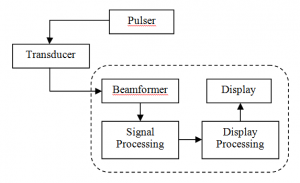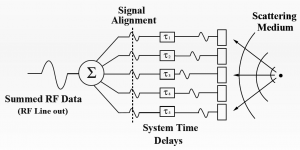Digital Processing and Beamforming for Portable Medical Ultrasound Imaging
- Category: Circuits & Systems, Medical Electronics
- Tags: Anantha Chandrakasan, Bonnie Lam
An ultrasound image is formed from a collection of ultrasonic beams transmitted and received by an array of transducer elements. As the resolution of an image and the range over which an image is to be formed increase, so do the number of these transducer elements and the corresponding digital processing units. The intensive signal processing power required for ultrasound imaging [1] means that conventional ultrasound systems are often large and expensive, and this demand for processing power can only worsen as more transducers and signal channels are implemented. Three-dimensional (3D) ultrasound images, composed of a set of adjacently acquired two-dimensional images, are formed using two-dimensional (2D) transducer arrays [2] . This further increases the signal processing requirement: if a one-dimensional (1D) array of N transducers costs a complexity of N, the corresponding 3D image would require a complexity of N2. Countering these trends is the movement to smaller form-factors for portable ultrasound systems that are less operator-dependent, warranting the use of advanced algorithms and architectures for back-end digital processing. Figure 1 illustrates a simplified block diagram of a typical ultrasound system.
Beamforming, which in its simplest form involves delaying, scaling, and summing to produce a coherent signal from the collection of received beams, has been identified as an area for algorithmic research and development [3] . Figure 2 shows a schematic describing the delay-and-sum operation. This work explores advanced beamforming techniques with an efficient and low-power hardware implementation in mind. Specifically, synthetic apertures and adaptive beamforming are implemented to reduce the number of channels and the data rate required for image formation. The power and area reduction in a low-power implementation of the beamformer are demonstrated.
- M. Ali, D. Magee, and U. Dasgupta, “Signal processing overview of ultrasound systems for medical imaging,” Texas Instruments, Dallas, TX, SPRAB12, 2008. [↩]
- D. Kouame, J. M. Gregoire, L. Pourcelot, J. M. Girault, M. Lethiecq, and F. Ossant, “Ultrasound imaging: signal acquisition, new advanced processing for biomedical and industrial applications,” in Proc. IEEE International Conf. on Acoustics, Speech, and Signal Processing, vol. 5, pp. 993-995, Mar. 2005. [↩]
- S. Stergiopoulos, Advanced Signal Processing Handbook: Theory and Implementation for Radar, Sonar, and Medical Imaging Real-Time Systems. Boca Raton: CRC Press, Inc., 2000. [↩]
- J. U. Quistgaard, “Signal acquisition and processing in medical diagnostic ultrasound,” IEEE Signal Processing Magazine, vol. 14, no. 1, pp. 67-74, Jan. 1997. [↩]
- M. L. Palmeri, “Ultrasound beamforming and image formation,” presented at Radiological Society of North America, 2007, p. 7 [↩]

